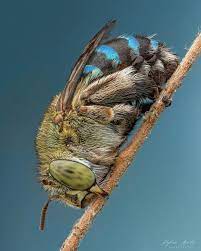Amegilla Zonata
| Blue Banded Bee | |
 | |
| Amegilla zonata foraging on a flower | |
| Classification | |
| Genus | Amegilla |
| Species | A. zonata |
| Class | Insecta |
| Order | Hymenoptera |
| Family | Apidae |
| Taxonomy authority | |
| Synonyms | |
Blue banded bees (Amegilla zonata) are solitary bees in the family Apidae, known for their striking blue and black stripes and their role as effective pollinators. Native to India and other parts of the world, these bees exhibit unique behaviors such as buzz pollination, gregarious sleeping clusters, and distinct foraging preferences. This article summarizes research on their behavior, floral preferences, and ecological significance based on a 2018 study conducted in Tamil Nadu, India.[1]
Description
Amegilla zonata is characterized by its vibrant blue bands across a black abdomen. Both male and female bees are active floral visitors, with females collecting pollen and nectar while males primarily sip nectar.[2] They are non-aggressive and rarely sting, with stings causing only mild discomfort akin to a pinprick.[3]
Behavior
Foraging and Floral Resources
Blue banded bees are active foragers from just before dawn (around 6:00 AM) until dusk (approximately 6:30 PM). They collect nectar and pollen from 21 crop plants and 12 weed species, with a strong preference for yellow flowers, followed by white and purple.[4] Predominantly visited plant families include Fabaceae, Solanaceae, and Cucurbitaceae. Notable crops include eggplant (Solanum melongenum), tomato (Lycopersicon esculentum), and cucumber (Cucumis sativus), where they perform buzz pollination by vibrating anthers to release pollen.[5]
Mating Behavior
Natural mating was not observed in the study, but forced mating in captivity revealed that males extend their middle and hind legs before copulation, while females approach from below. During mating, the female lies on her back with the male above her.[6] Mating typically occurs at nesting or foraging sites.
Sleeping Clusters
Blue banded bees form sleeping clusters on dried weeds such as Achyranthes aspera and Chloris barbata, typically near food plants. Cluster formation begins just before sunset (5:49 PM to 6:19 PM) and dissolves before sunrise (5:45 AM to 6:12 AM).[7] These clusters are usually male-dominated, though female-biased and sex-mixed clusters occur rarely. Interspecific clusters with cuckoo bees (Thyreus sp.) and leaf cutter bees (Megachile sp.) have also been observed.[8]
Nest Defense
Female bees guard their nests by positioning themselves at the entrance, blocking access with their bodies. They may sting intruders if provoked, though sting autotomy (loss of the sting) does not occur.[9]
Ecological Significance
Amegilla zonata plays a vital role in pollinating crops, particularly those in the Solanaceae family like tomatoes and eggplants, where buzz pollination enhances yield.[10] Their preference for yellow flowers and diverse floral resources underscores their importance in both agricultural and natural ecosystems.
Research
The primary source for this article is a 2018 study by Sandeep KJ and Muthuraman M, conducted at Tamil Nadu Agricultural University. Observations were made on floral resources, mating behavior, and sleeping habits during April 2016.[11] The full study is available at https://www.researchgate.net/publication/336069508 ResearchGate.
References
- Behavior of Blue Banded Bees, Sandeep KJ and Muthuraman M, 2018, P.2365
- Behavior of Blue Banded Bees, Sandeep KJ and Muthuraman M, 2018, P.2366
- Behavior of Blue Banded Bees, Sandeep KJ and Muthuraman M, 2018, P.2365
- Behavior of Blue Banded Bees, Sandeep KJ and Muthuraman M, 2018, P.2366
- Behavior of Blue Banded Bees, Sandeep KJ and Muthuraman M, 2018, P.2366
- Behavior of Blue Banded Bees, Sandeep KJ and Muthuraman M, 2018, P.2367
- Behavior of Blue Banded Bees, Sandeep KJ and Muthuraman M, 2018, P.2367
- Behavior of Blue Banded Bees, Sandeep KJ and Muthuraman M, 2018, P.2367
- Behavior of Blue Banded Bees, Sandeep KJ and Muthuraman M, 2018, P.2367
- Behavior of Blue Banded Bees, Sandeep KJ and Muthuraman M, 2018, P.2365
- Behavior of Blue Banded Bees, Sandeep KJ and Muthuraman M, 2018, P.2365-2370
